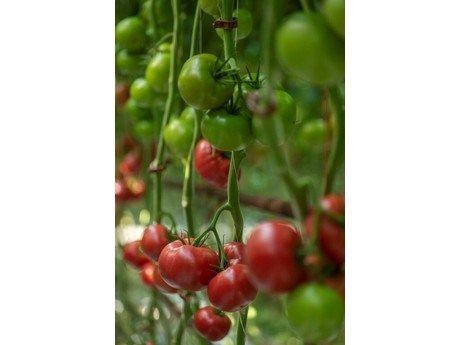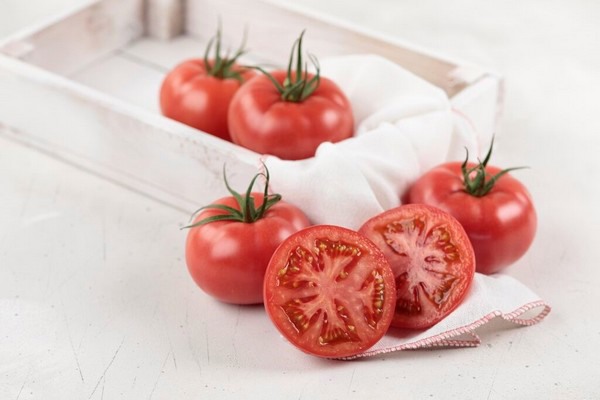An international company. That’s definitely how you can describe FoodVentures, which operates greenhouse in Ukraine, Georgia, Kazakhstan and China. “We take over the complete operation on P&O responsibilities, growing crops like tomatoes, lettuce and leafy greens,” explained Mikel Honders, the company’s COO, during the session ‘Growing for consumer needs’ on the Vision Stage at the GreenTech in Amsterdam.

‘Taking over’
The way it works is like this, Mikel explains: “We take over from an investor – in our China case there’s a property developer who owns a greenhouse but doesn’t have operational experience. We, as an operator, pay a fixed rent for using the greenhouse and then run it on P&O responsibility. We decide what we grow, what we pay for the seeds, we sell the products… we completely run the greenhouse.”

Kawaguchi
In the Chinese greenhouse mentioned by Mikel, the choice was made to also grow Rijk Zwaan’s Kawaguchi tomato variety. Qin Yanlei, grower with FoodVentures China, explained this choice in a video that was shown during the event: “Last year we tried six pink beef varieties. Kawaguchi RZ was the best one. This year we’re growing more Kawaguchi. It brings us high yield, equal size, and the Brix is around 6. I like to grow this variety, and to eat it as well!”
Just Roos, CCO of FoodVentures China, adds: “We are growing Kawaguchi RZ in our greenhouse here, and this is one of the varieties people love in China. We grow it because there is huge demand. Some of the biggest sales channels in China have rebranded this variety and gave it their own brand name. We also sell this in other high-end retail chains in Shanghai, and the feedback is very, very good.”

Testing tomatoes
Back from the screen to the stage, where Mikel continues the story of FoodVentures China. “We started about two years ago, when the greenhouse was built, in Shanghai, where we do the operations. Our first trial was about 4 to 5 months, growing 10 to 12 different varieties of tomato, to test it with the market.”
Exploring the market
FoodVentures works with Rijk Zwaan on all their projects. “The countries we operate there’s not always a set market, it’s not always clear what to grow. So in the beginning we always analyze the market needs. We work close with Rijk Zwaan to get understanding what retail channels need and what the consumer actually wants”
The way they do that is by organizing tasting panels, testing them in retail and restaurants. “Based on the feedback from consumers we decide what to grow,” Mikel adds.
Challenges
Sounds good, but there are also challenges, like the climate. “Where we go it’s either a new climate, a new greenhouse, so climate is a real challenge. But our biggest challenge is COVID – we just had a lockdown of two months in Shanghai. Everybody literally slept in the greenhouse for two months.”
That also gave them an opportunity, however. “From that moment we couldn’t supply to retail channels anymore, we couldn’t supply to markets – everything stopped. So we went from 90% B2B sales to 100% B2C sales. So we could get our products directly to the people, selling pallets of Kawaguchi tomatoes directly to consumers.”
Consumer… and grower
So it turned out that Kawaguchi was a good option for consumers, but it’s also good for the grower, as Jan Doldersum, Manager Chain & Retail at Rijk Zwaan, explains. “You need the right resistances, yield and equal size – those are really important other characteristics of the variety. So the grower is happy, and in the end you also have a happy consumer.”
Alibaba
Rijk Zwaan also supports in horticultural projects by connecting growers and retailers. “One of the first visits I had with one of Mikel’s colleagues was to the Alibaba headquarters in Hangzhou,” Jan goes on to say. “Alibaba is interesting because they have the online and offline sales channel. At that time we visited their offline Hema stores, but now we’re also connected directly to the Alibaba agricultural [online] team.”
In a video that was then shown, Shi Jing, of Alibaba’s Digital Agriculture Business Unit, said something about this cooperation. “Alibaba Group is one of the first companies in China to enter retail e-commerce. In 2020, the transaction volume of agricultural products already exceeded 300 billion Chinese yuan. The fresh fruit and vegetable category is always the core category and the category with the highest repurchase rate.”
He gives pepper products as an example of that. “These products contribute a very large sales volume in our system. The annual sales of pepper products on the TaoCaiCai platform and Tao’s series sales channels reach hundreds of millions of yuan. We noticed that consumers are not just simply satisfied with ordinary green peppers. Especially younger consumers, they want to buy colorful peppers with more sugar content, more suitable for raw consumption or in salads.”
“Seeing this trend from marketing data information, in order to better meet the needs of consumers, we worked together with Rijk Zwaan, and found some sweet pepper growers at the upstream end who can provide these products which meet the needs of consumers, and introduced online and offline sales channels from Alibaba.
“We hope in the future, by constructing a more efficient system in Ali’s supply chain, and working together with Rijk Zwaan, to maintain a close connection with growers and producing centers. Really connect good varieties with growers, even small farmers, and connect those good varieties with consumers’ dining tables, to create a two-way positively interacted system – from the field to the table.”
Golden triangle
This partnership is part of the strategy that Jan describes as the ‘golden triangle’. “You have the seed company, the grower and the retailer, then you connect them and bring them together. And of course we’re very happy that Alibaba are so outspoken in saying they appreciate this cooperation, and I think what we can bring to their assortment is excitement in the form of new products.”
In addition to that innovation aspect, what Rijk Zwaan also does is bringing the supply chain together. Jan: “We call that the sourcing tool, finding sourcing solutions: Can we find growers who can produce according to their specifications? That means retailers can have a stable supply and year-round quality. And that’s also how we helped FoodVentures in finding retailers to sell off their products.”
For more information: Rijk Zwaan
Rijk Zwaan
info@rijkzwaan.com
www.rijkzwaan.com
